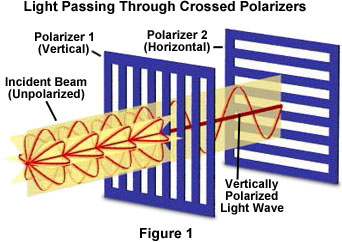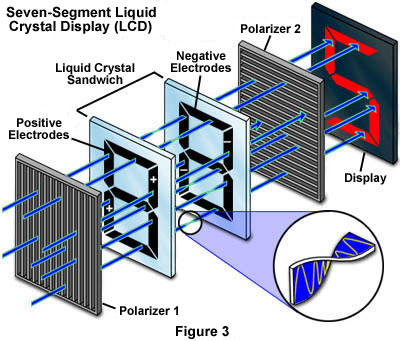Natural sunlight and almost every other form of artificial illumination transmits light waves whose electric field vectors vibrate in all perpendicular planes with respect to the direction of propagation. When the electric field vectors are restricted to a single plane by filtration, then the light is said to be polarized with respect to the direction of propagation and all waves vibrate in the same plane.

This concept is illustrated in Figure 1 below, and we have also constructed an interactive Java tutorial that explores the interaction of light waves with polarizers. In this example, the incident light electric field vectors are vibrating perpendicular to the direction of propagation in an equal distribution of all planes before encountering the first polarizer. The polarizers illustrated above are actually filters containing long-chain polymer molecules that are oriented in a single direction. Only the incident light that is vibrating in the same plane as the oriented polymer molecules is absorbed, while light vibrating at right angles to the plane is passed through the first polarizing filter. In Figure 1, polarizer 1 is oriented vertically to the incident beam so it will pass only the waves that are vertical in the incident beam. The wave passing through polarizer 1 is subsequently blocked by polarizer 2 because the second polarizer is oriented horizontally with respect to the electric field vector in the light wave. The concept of using two polarizers oriented at right angles with respect to each other is commonly termed crossed polarization and is fundamental to the practice of polarized light microscopy.
Unpolarized incident light (natural sunlight, for example) is polarized to a certain degree when it is reflected from an insulating surface like water or a highway. In this case, light waves that have the electric field vectors parallel to the surface are reflected to a greater degree than those with different orientations. The optical properties of the insulating surface determine the exact amount of reflected light that is polarized. Mirrors are not good polarizers, although many transparent materials will be very good polarizers, but only if the incident light angle is within certain limits. In this case, the particular angle inducing maximum polarization is known as the Brewster angle given by the expression:
where n is the refractive index of the medium, θ(i) is the angle of incidence, and θ(r) is the angle of refraction.
This type of polarized light is often termed glare and can be easily demonstrated by viewing the distant part of a highway on a sunny day. The reflection and polarization of light according to the Brewster theory can be more thoroughly examined with our Brewster Angle Java Tutorial. Light reflected by the flat surface of a highway is partially polarized with the electric field vectors vibrating in a direction that is parallel to the ground. This light can be blocked by polarizing filters oriented in a vertical direction as illustrated below in Figure 2 with a pair of polarized sunglasses.

The lenses of the sunglasses have polarizing filters that are oriented vertically with respect to the frames. In the Figure 2 above, the blue light waves have their electric field vectors oriented in the same direction as the polarizing lenses and, thus, are passed through. In contrast, the red light wave is perpendicular to the filters and is blocked by the lenses. Polarizing sunglasses are very useful when driving in the sun or at the beach where sunlight is reflected from the surface of the road or water leading to glare that can be almost blinding.
One of the most common uses of polarization today is the liquid crystal display (LCD) used in numerous applications including wrist watches, computer screens, timers, clocks, and many others. These devices are based upon the interaction of rod-like liquid crystalline molecules with an electric field and polarized light waves. The liquid crystalline phase exists in a ground state that is termed cholesteric where the molecules are oriented in layers where each successive layer is slightly twisted to form a spiral pattern. When polarized light waves interact with the liquid crystalline phase the wave is "twisted" by an angle of approximately 90 degrees with respect to the incident wave. This angle is a function of the helical pitch of the cholesteric liquid crystalline phase, which is dependent upon the chemical composition of the molecules (it can be fine-tuned by small changes to the molecules).
An excellent example of the basic application of liquid crystals to display devices can be found in the seven-segment LCD numerical display (Figure 3). Here, the liquid crystalline phase is sandwiched between two glass plates that have electrodes attached similar to those depicted in the illustration below. In figure 3, the glass plates are drawn with seven black electrodes that can be individually charged (these electrodes are transparent to light in real devices). Light passing through polarizer 1 is polarized in the vertical direction and, when no current is applied to the electrodes, the liquid crystalline phase induces a 90 degree "twist" of the light and it can pass through polarizer 2, which is polarized horizontally and is perpendicular to polarizer 1. This light can then form one of the seven segments on the display.

When current is applied to the electrodes, the liquid crystalline phase aligns with the current and loses the cholesteric spiral pattern. Light passing through a charged electrode is not twisted and is blocked by polarizer 2. By coordinating the voltage on the seven positive and negative electrodes, the display is capable of rendering the numbers 0 through 9. In this example the upper right and lower left electrodes are charged and block light passing through them, allowing formation of the number "2".
Polarization of light is very useful in many aspects of optical microscopy. The microscope configuration uses crossed polarizers where the first polarizer (termed: the polarizer) is placed below the sample in the light path and the second polarizer (termed: the analyzer) is placed above the sample, between the objective and the eyepieces. With no sample on the microscope stage, the light polarized by the polarizer is blocked by the analyzer and no light is visible. When samples that are birefringent are viewed on the stage between crossed polarizers, the microscopist can visualize aspects of the samples through light rotated by the sample and then able to pass through the analyzer. The details of polarized light microscopy are thoroughly discussed in our microscopy section of this primer.